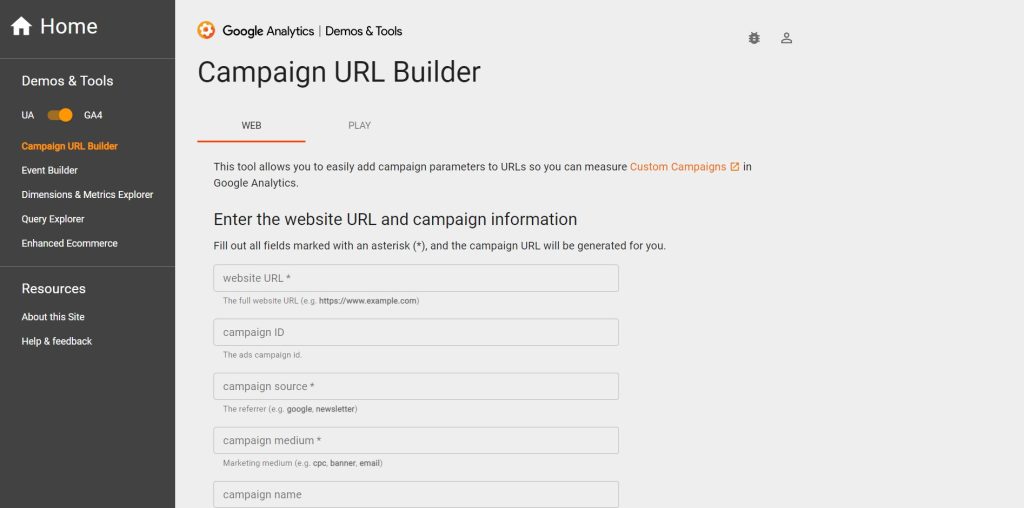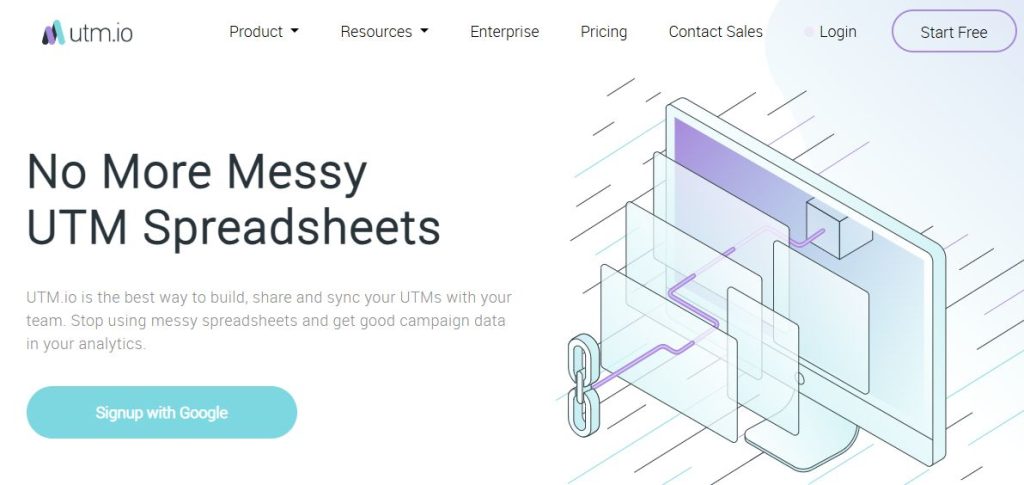Сервіси для генерації UTM-міток
Що таке UTM-мітки і навіщо вони потрібні
UTM-мітки – це невеликі коди, які додаються до URL-адрес веб-посилань з метою відстеження та аналізу їхнього джерела та ефективності в маркетингу. Ці мітки складаються з таких параметрів, як джерело (utm_source), тип медіа (utm_medium), назва кампанії (utm_campaign), ключове слово (utm_term) та контент (utm_content). Вони дозволяють маркетологам та аналітикам визначити, звідки приходить відвідувач на веб-сайт і яка конкретна кампанія чи рекламний матеріал залучили цього відвідувача. УTM-мітки відіграють фундаментальну роль в аналітиці маркетингу, дозволяючи більш точно вимірювати та аналізувати результати маркетингових зусиль, оптимізувати рекламні бюджети та приймати обґрунтовані рішення для покращення ефективності маркетингових кампаній.
Переваги відстеження маркетингових джерел
Відстеження маркетингових джерел за допомогою UTM-міток надає безліч переваг. По-перше, ви можете точно визначити, які канали дають найбільше трафіку та конверсій. Це дозволяє оптимізувати бюджети, зосереджуючи ресурси на найбільш ефективних джерелах. По-друге, UTM-мітки дозволяють проводити аналіз по кожному елементу кампанії, що допомагає вам зрозуміти, які стратегії та контент найбільш успішні. Зрештою, вони дозволяють покращити сегментацію та аналіз цільової аудиторії.
ТОП сервісів для генерації UTM-міток
Існує кілька визначних сервісів, призначених для генерації UTM-міток, які значно полегшують роботу маркетологів та аналітиків.
Esputnik UTM-генератор
Сервіс Esputnik UTM-генератор надає зручний та інтуїтивно зрозумілий інтерфейс для створення UTM-міток. Цей інструмент також інтегрується з розсилкою електронної пошти, що дозволяє проводити аналіз ефективності email-маркетингу з використанням UTM-міток.
Google Analytics Campaign URL
Ще одним потужним інструментом є Google Analytics Campaign URL Builder. Цей інструмент розроблений Google і забезпечує детальне відстеження та аналіз UTM-міток. Він особливо корисний для тих, хто активно використовує Google Analytics для моніторингу та аналізу даних про трафік та конверсії на своєму веб-сайті.
UTM.io
UTM.io — це зручний онлайн-сервіс для генерації, управління та збереження UTM-міток. Він ідеально підходить для маркетологів, які працюють із великим обсягом рекламних кампаній. Основні функції включають створення міток за шаблонами, автоматичне збереження історії, інтеграцію з інструментами аналітики (наприклад, Google Analytics), а також можливість командної роботи. Сервіс має безкоштовний тариф з базовими функціями та платні плани для розширених можливостей, таких як кастомізація міток та доступ до аналітики.
UTM.io допомагає оптимізувати процес створення міток, уникаючи помилок, і економить час команди. Чудовий вибір для компаній, які активно працюють з UTM-мітками та потребують систематизації роботи.
Сегментація та аналіз цільової аудиторії через UTM-мітки
Сегментація цільової аудиторії є ключовою стратегією у сучасному маркетингу. За допомогою UTM-міток це завдання стає ще більш ефективним, дозволяючи створити точні портрети різних груп клієнтів та аналізувати їхню поведінку.
1. Створення UTM-міток для різних сегментів клієнтів
Створення UTM-міток для різних сегментів аудиторії може допомогти у відстеженні, як різні групи реагують на ваш контент чи рекламу.
Приклад: Уявимо, що ви продаєте спортивне харчування та поділяєте свою аудиторію на два основні сегменти: професійних спортсменів та людей, які займаються фітнесом у режимі «здоров’я». Створивши різні UTM-мітки для кожного сегмента, ви зможете виміряти, які продукти чи рекламні матеріали більше подобаються кожній групі, та оптимізувати маркетингову стратегію відповідно до цих уподобань.
2. Розуміння поведінки різних груп користувачів
UTM-мітки можуть також допомогти в аналізі поведінки різних сегментів аудиторії на вашому веб-сайті або в програмі.
Приклад: Припустимо, ви керуєте онлайн-магазином одягу та поділяєте свою аудиторію за віковими групами: молодь (18-25), дорослі (26-40) та люди старшого віку (40+). Використовуючи UTM-мітки для кожної групи, ви можете аналізувати, які категорії товарів чи стилі користуються найбільшою популярністю серед різних вікових груп, і на основі цих даних будувати точкові рекламні кампанії.
Поліпшення рекламних кампаній через UTM-аналітику
З моменту появи UTM-міток (Urchin Tracking Module) можливості маркетологів у сфері аналітики збільшилися багаторазово. Ці параметри дають змогу відстежувати ефективність рекламних кампаній на новому рівні та коригувати стратегії маркетингу на основі конкретних даних. Розглянемо два ключові аспекти цього підходу.
1. Визначення найуспішніших джерел трафіку
За допомогою UTM-міток можна визначити, звідки саме відвідувачі переходять на ваш сайт. Це особливо корисно в оцінці ефективності різних рекламних каналів.
Приклад: Уявимо, що у вас є рекламна кампанія, розміщена на трьох різних платформах: Facebook, Twitter та Google Ads. Використовуючи UTM-мітки, ви можете визначити, яке джерело приваблює найбільше відвідувачів та яке з них має найвищий коефіцієнт конверсії. Наприклад, Facebook приносить 60% трафіку з 10% конверсією, у той час як Google Ads — лише 20% трафіку з 5% конверсією, ви можете перерозподілити бюджет на користь найуспішнішого каналу.
2. Коригування стратегії на основі отриманих даних
UTM-аналітика не просто дозволяє визначити джерела трафіку, а й дає можливість аналізувати, які конкретні елементи рекламних кампаній працюють найкраще.
Приклад: Допустимо, ви проводите рекламну кампанію з різними видами оголошень: відео, банери, текстові оголошення. Використовуючи UTM-мітки, ви можете відстежувати, який тип оголошення найбільш ефективний у кожному джерелі трафіку. Виявивши, що відеооголошення працюють краще на Facebook, а текстові оголошення на Twitter, ви зможете коригувати свою стратегію, щоб максимізувати ефективність кампанії.
Висновок
Насамкінець, UTM-мітки є невід’ємною частиною сучасної маркетингової аналітики та стратегії. Вони дозволяють маркетологам та аналітикам точно відстежувати джерела трафіку, визначати найуспішніші кампанії та джерела, а також коригувати стратегію на основі отриманих даних. UTM-мітки дозволяють максимізувати ефективність рекламних зусиль, оптимізувати витрати та підвищувати ROI.
Часті питання
Що таке UTM-мітки?
UTM-мітки — це параметри, які додаються до URL-адрес, щоб відстежувати джерела трафіку в аналітичних системах, наприклад, Google Analytics.
Які основні елементи UTM-мітки?
До основних елементів належать: джерело трафіку (utm_source), канал (utm_medium), назва кампанії (utm_campaign), ключове слово (utm_term) і контент (utm_content). Вони надають детальну інформацію про трафік.
Чому варто використовувати сервіси для генерації UTM-міток замість ручного створення?
Сервіси допомагають уникнути помилок у написанні міток, автоматизують процес і забезпечують зручність роботи з шаблонами.
Які найпопулярніші сервіси для створення UTM-міток?
Серед популярних сервісів — Google Campaign URL Builder, utm.io.
Чи можна налаштувати шаблони для UTM-міток у сервісах?
Так, багато сервісів дозволяють створювати шаблони, щоб прискорити процес створення стандартних міток.
Чи є мобільні додатки для генерації UTM-міток?
Так, деякі сервіси, як-от utm.io, пропонують мобільні додатки для роботи на ходу.
Як інтегрувати сервіси для створення UTM-міток з аналітичними інструментами?
Достатньо використовувати створені UTM-мітки в URL-адресах; аналітичні системи автоматично розпізнають їх і додають дані в звіти.
Чи дозволяють сервіси зберігати історію створених міток?
Так, платні сервіси, як-от utm.io, забезпечують збереження історії для повторного використання міток.
Як уникнути помилок при створенні UTM-міток?
Використовуйте сервіси для автоматизації, дотримуйтесь стандартів найменувань і перевіряйте URL перед запуском кампанії.
Чи можна використовувати кирилицю в UTM-мітках?
Можна, але краще уникати, оскільки кирилиця може некоректно відображатися в URL і викликати проблеми в аналітиці.
Експерт в області інтернет-маркетингу. Керівник маркетингового агентства MAVR.
Бізнес-ступінь “Майстер ділового адміністрування” (MBA).




